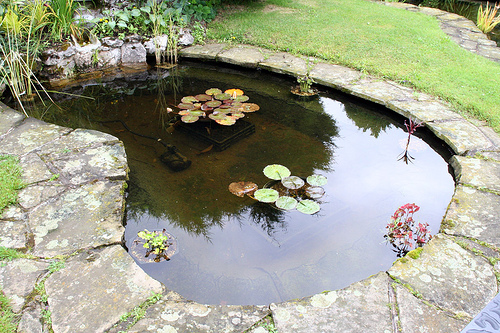How To Build a Garden Pond
Why You Should Own Garden Pond
In my humble opinion no landscape garden is complete without a water feature. Garden ponds can be a nice little place full of life and surprises of mother nature. A small garden pond can enrich your life and will add and beautiful surroundings.

Want to Have Your Own Paradise in the Garden?
Every time I get home, I let my eyes dwell on olive green leaves of water lilies, colourful flowers and merry group of gold fish which are playing between aquatic plants. I sat on the grass, close my eyes and listen to the murmur of the stream. Fish collect in a compact group and wait for food. Dove fly down next to me and quenches the thirst in the brook. Green and blue dragonflies fly above the water lilies and deposit their eggs among underwater vegetation. I started to feel at ease from my busy day and enjoy the moist air at the pond. I am calm and relaxed, worries are gone.
The beauty of water reflection, soothing murmur of moving water and life that is attracted by water makes the pond a popular place for all people, regardless of culture or age.
Relaxation At The Garden Pond In Every Season
Pond is a snapshot of nature, which eventually grows into a complete biotope unit. It’s like a living thing which is changing and evolving. For a healthy and clean water are important even the smallest parts of the pond – from the invisible microorganisms, through different plants and to lively fish.
We need to know that the Far East countries are the ponds for centuries an important addition to gardens and houses. The pond and its running water can greatly reduce the negative Chi and can bring positive Chi in our homes. The pond can certainly have a significant influence on inflow of positive energy in our home. Additions of rocks in the pond will soften balance of Yang energy and plants will have positive affect on the balance of Yin energy. And even if we leave aside the whole Feng Shui, we can talk about the pond as a relaxing garden area, which can be used for meditation. Pond with vivid fish and rippling water can change boring garden in a living place, which is highly inspiring and extremely relaxing.
Are You Ready To Rock?
Firstly we should check if our garden allows building pond. If we cannot set up the pond, we should at least think about setting up water fountain. But let us focus now to the pond.
When looking for a location for your pond you should take into account the size and depth of the pond and its vegetation. If you want to have lush vegetation, the pond must be at least 4-5 hours per day exposed to direct sunlight. The ideal location is in a full or partial shade during peak midday summer heat. Because of autumn leaves, it is recommended that the pond is not standing right next to the trees and bushes.
A Practical Guide to Building & Maintaining Your Pond
The book is a wonderful guide to the world of garden ponds. On more than 200 pages you will find all necessary information about setting up and maintaining the ponds, as well as plenty of practical advice on how to overcome any difficulties. Yes, difficulties can occur – the pond is as living creature.
Are You Convinced? Wanna Have One?
Well, we have decided. We will make a pond. Now what? Most garden ponds are made using plastic pre-formed pond or from special pond liner. Let’s look at both systems.
Plastic pre-formed pond
If you have limited space, I recommend the plastic pre-formed pond. Many plastic pre-formed pond models are already equipped with parts for the swamp, with edges for plant and animal ecosystems and different levels, which offer diverse conditions for plant growth.
Advantages: simple and rapid construction.
Weaknesses: limited size and shape.
How To Install a Pre-Formed Pond
Convinced? You might want to try one of these?
Liner Ponds
If you want a pond framed by your own notions of form and depth, it is an appropriate solution pond from the liner, which offers you design freedom. You can purchase pond liners online or from retail outlets.
Advantages: plants and fish are provided with more living space.
Weaknesses: sophisticated and more expensive layout compared to the plastic preformed pond.